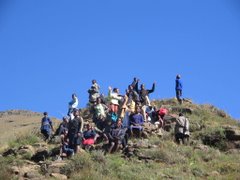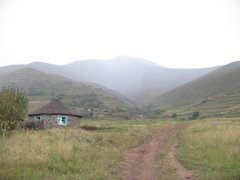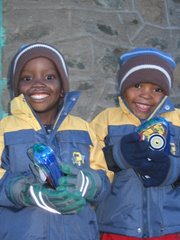Thursday, March 30th, 2007
Good afternoon, It is now 1 :16 p.m. Lesotho time (about 6 :16 a.m. in Ottawa)
(I'm finally getting around to sending this at 2:44 p.m. - most of you will be up already or getting up really soon! Have a fantastic day!)
I attempted to write this message this morning, and got about halfway through when the internet abruptly stopped working and my message was lost. I’ve been gone a couple of hours and just came back in, asking the manager if the internet will continue to work this time, he said that he wishes it will. I’m keeping my fingers crossed (which is very difficult when you type), but as a precaution, am writing this e-mail on Microsoft Word. When I was first in here this morning, I was met with lots of new e-mail messages. My eyes filled with tears and I was left clumsily wiping them away as I read message after message of love and encouragement. Thank you to all of you who are reading these messages and especially those of you who are taking the time to respond. The support means SO much to me. Thank you thank you thank you!
Today my shopping has continued, I have bought all the jackets and boots save for one set. I’ll stop by the shops this afternoon to look again.
Let me tell you about my hut in Mahlekefane. I live in a round hut (called a rondavel), made of mud and cow dung with a beautiful thatch roof. It is quite roomy – with a radius of about 9 or 10 feet. There are a few closets in the single room, filled with the clothing and blankets of the Letata family (my hosts). I sleep on a double bed which has a mattress and a frame and is off the floor. I sleep under three Basotho blankets – very cozy and with a pillow made of my unused clothing. The pillows here are too lumpy for my liking, and after a few nights using them, I gave up for the softer clothing alternative.
I have bedside tables attached to my bed, on which I rest several candles – I like lots of light. When they’re extinguised at night, the darkness is so totally complete that you cannot see a thing. The mud floor is covered in linoleoum simulating wood and there is a short dressing table with three large mirrors. I was actually looking forward to being away from mirrors, but now I actually have to look at myself each morning, so I am happily using the warm water that my ‘M’e (Mother) brings me to bathe with.
I even have a small table in my hut, on which I sometimes eat (when I can escape the watchful eyes of all my friends in the village – they love to watch me eat!) soup. I am consistently fed HUGE meals and once in a while, need a break and have some instant soups in my hut. There is a huge bag of maize meal that the Letata family keeps in the hut in which I am living. There are also kitchen type cupboards in which they hold many dishes and cooking implements, as well as extra candles, sugar, flour, etc.
Like most families in Mahlekefane, the Letatas have more than one hut. Each hut is like a sepearte room and is used for a different purpose. I am sleeping the the ‘storage’ hut and they sleep in the ‘kitchen’. Pietir Letata is a coal miner who comes home for one or two nights a month and Ntsiseng, the 12 year old daughter lives with her grandparents, so it is just Menkalimeng (my ‘M’e) and Mahkumalo. They sleep together on a single cot in the corner of the very bare kitchen hut. When I asked why they do not use the beautiful hut in which I sleep, as I would be very happy to sleep on a single bed, ‘M’e tells me that she hates the cold. The kitchen hut is much warmer, as it is where all the cooking happens. Don’t think that I am being neglected though, the past few nights were pretty cold and I was given extra blenkets and the use of a neighbour’s heater for the evening (I’m being taken care of so well that I feel awful for all the people who need so much more and volunter to help ME out).
Anyway, my hut is a traditional Basotho hut, but well taken care of (like everything here! The four year olds learn to shine their shoes daily), and very comfortable. There is obviously no electricity or running water, but I will often wake up, feeling like I am in my own bed in Ottawa.
On the first day of the feast for the returning initiates, the men paraded into the field surrounded by their dogs. The dogs in Lesotho are not like our pets in Canada, some are beautiful, but they are trained not as housepets and companions but as vicious guards. The herders (the initates) have the most beautiful healthy dogs. When they arrived into the village, led by their proud dogs, each man and dog was decorated in red ochre. At the commencement of the ceremony, with the dogs settling in next to their singing masters, there was one dog sitting on the periphery with the women who I’m certain was frowning. He looked so sad. He kept approaching the area wiht the painted dogs and looked sadly around, obvioulsly envious of their adornments and high status. I got a photo of him hanging his head after he realized he truly didn’t fit in.
The family with which I live has a cat, named ‘katse’. The animals are not given names, but are simply called their Sesotho names (a dog is an ‘nja’). He is a tiny little cat who is very snarly and hissy. When I have tuna, I give him the water from the can. I’m trying to befriend him, but it’s not really working. His ears are both snipped at the tops. This is so that he will stay near home. Apparently he was running away to the ‘forest’ (there is, in fact, nothing CLOSE to a Canadian forest in Mahlekefane – there are maybe three gatherings of two small trees each), so I’m not sure where the cat was going. Nor am I sure where kids go to the toilet, as I am told they go in the ‘forest’), and in order to scare him from the forest and back home, Ntate Letata took him to the forest and snipped his ears. Thus forth, he stays near home. Yikes.
I am working wtih the children on basic vocabulary, including colours – which are fun and easy to teach, as you can point at anything to practice. Before I left for Hlotse yesterday morning, I went to visit my pal, Masefatsa who was resting in bed after a sudden seizure the night before (I am going to the hospital with her and her grandmother on Sunday). She was feeling OK, but tired and achy (understandably), and she began her favourite game of telling me colours of things. I would point at something and she would say the colour, my bracelet, ‘rrrred’ (she rolls her ‘r’s adorably), her blanket, ‘grrrreen’, a plant, also ‘grrrreen’. Then she pointed at my hand and said ‘white’. I pointed at her hand and asked what colour, she said, ‘grrrrreen’. Whatever you say. She also loves to be tickled – The Round and Round the Garden Game, Spiders Crawling Up Your Bag (note: this was supposed to say "Spiders Crawling Up Your Back", but it's pretty funny to leave the original typo) , and This Little Piggy. She’ll climb into my lap and present me with whatever part of her body she wants tickled. For the Round and Round, I am presented with a tiny perfect palm, Spiders get her head tucked down and her back rounded and the Piggies mean her shoe is kicked off and her tiny toes are in the air.
The kids have started to lead one another in the ‘Hands Up’ game we play. It’s great – they practice their English and warm up from the cold. One person shouts out directions which the group repeats and then does the action. They love ‘wiggle, wiggle, wiggle’ and ‘shake, shake, shake’. Everyday I try to expand the actions and vocabulary, but when they lead, they stick to the old standbys!
The day that the classrooms were being smeared, the kids were able to play with their toys outside. I saw some amazing things – the most detailed cars and trucks made out of wire (one had a trunk filled with Coke cans, rearview mirrors and even an accessory hanging from the main rearview!), the hoops and sticks similar to those who remember studying pioneer Canada, rocks used to play a checkers type game on a larger rock on which a gameboard has been set up using a small rock to carve into the surface, and many animals and houses made out of clay from the area surrounding the spring (we get water from the freshwater spring and I chlorinate it to drink). The toys I brought have been incorporated into their play beautifully.
I have been practising daily carrying things on my head, one of my steps in becoming a true ‘Masotho woman’. I carried a five litre bucket of water from the spring to the school with just one hand for balance. Pretty good. The women are helping me by constructing rings out of scarves for me to rest on my head as support. I am getting better though. Don’t be surprised if you see me walking the streets of Ottawa with a sewing machine or logs on my head (I have seen women carrying the most incredible things!)
I’ve pulled out my puppet (who’s name is ‘Bapala’ – Sesotho for play) a few times to hilarious reactions, some kids were initially terrified. Then Bapala started kissing some kids and the others all wanted in on the action. When I introduced Bapala to the adults, their reactions were identical – a few rough, grown men screamed and ran away in terror to the laughter of their friends, while some happily accepted Bapala’s kisses. One man tried to get a kiss from me instead of Bapala but I laughed it off (as I do with the numerous marriage proposals I recieve each day. People think that because I am white, I am rich and am their ticket to a better life. I wonder how one of these forward men would react if I just up and said yes. I’m not going to try, for fear that it would be binding!) Bapala now has a messy mouth and tongue from kissing so many people, but he and his fans are happy!
I gave the soccer balls along with other sports and school equpement to the principal, ‘M’e Ratia on Monday, and things were distributed on Tuesday afternoon. Along wtih the things I had brought, about 100 hats and a bunch of toothbrushes that were donated by other Help Lesotho volunteers were given out. The toothbrushes and paste were given to hte double and single orphans. A child here who has had one parent die is called a single orphan, and what we would call an orphan is here called a double orphan. The hats were given to the double orphans and all of the kids in calss one (the equivannet of our grade one, but with a big range of ages, from three to nine). ‘M’e Ratia handed out the new soccer balls, one to the girls for net ball (esentially basketball without the dribbling) and one to the boys for football (our soccer). The grade sevens are the ones who play, and all the other students, grade one to six stand on the sidelines. At first I thought, ‘how boring for them’. But then the game started. The grades one to sixes are responsible for provinding morale, they sing and dance (special morale boosting songs) and cheer things like ‘Many lions!’ in Sesotho (I think it’s like us yelling De-fence!) It’s fantastic to watch them in their physical education, the songs are all sung in beautiful harmony and the dance steps just add to the whole effect. The same thing happens when the grade sevens train for running. They run barefoot for 1 ½ hours as the younger students boost morale with song and dance. The kids are amazing runners and due to the high altitude and their incredible lung capacity, are fantastic competitors against the kids in the lowlands.
Primary school here is free and goes from grade one to grade seven. Grades 8-12 are high school and are called Form A, B, C, D and E. High school is expensive, so many children are unable to attend. This is why Help Lesotho sponsors many older children, as they are the ones who need help to pay school fees.
Tonight, the office staff and I have been invited to the neighbour’s for a maize roast (these are the three little boys and mother who live in a one room apartment next to the office). I have been recruited to bring marshmallows to roast and I’ll see if I can scrounge together some chocolate and graham cracker type cookies to let them try S’mores (there are cookies here called Maria biscuits which taste exactly like Arrowroots – yum!)
Even better than the Marie biscuits, though, are fat cakes. This is cakey dough that is deep fried in fat (usually corn oil these days). They are amazingly greasy and delicious adn taste like Tiny Tom’s doughnuts. On the way to the internet cafe, I saw a bunch of school girls heading past me carrying bags of them, apparently they can be purchased on the main street in town. I’ll go on a hunt after sending this e-mail!
Soon in Mahlekefane, there will be a World Food Program delivery and a cultural day with the traditional male and female dances. I can’t wait! I’ll tell you all about it in May, when I’ll be coming down next (Sam, I’ll be thinking of you on your birthday!)
Thursday, March 1, 2007
Lesotho Update #6
Labels:
Bapala,
Hands Up,
Initiates,
Initiation school,
katse,
Lesotho,
Letata family,
Mahlekefane,
Masefatas,
my hut,
running,
smearing,
soccer balls,
winter clothes
Subscribe to:
Post Comments (Atom)






2 comments:
Hello,
It's nice to see you out here. I'll be reading as much as possible. Nice initiative. So, do you speak Sesotho?
Hi Rethabile!
I found your website too and spent a little time checking it out...it's fantastic!
My Sesotho is very poor. It was passable when I was in Lesotho - I could communicate very basically, but since I've been home and not practising, it's gotten pretty bad.
Khotso,
Mathabo
Post a Comment